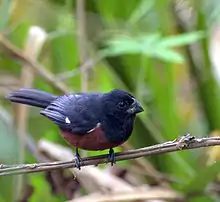Chestnut-bellied seed finch
The chestnut-bellied seed finch (Sporophila angolensis) is a species of bird in the family Thraupidae, but was until recently placed in Emberizidae.
| Chestnut-bellied seed finch | |
|---|---|
 | |
| male | |
 | |
| female | |
| Scientific classification | |
| Kingdom: | Animalia |
| Phylum: | Chordata |
| Class: | Aves |
| Order: | Passeriformes |
| Family: | Thraupidae |
| Genus: | Sporophila |
| Species: | S. angolensis |
| Binomial name | |
| Sporophila angolensis (Linnaeus, 1766) | |
| Synonyms | |
| |
It is found widely in shrubby and grassy areas in tropical and subtropical South America. It has been replaced west of the Andes (and in Central America) by the closely related thick-billed seed finch (S. funerea). The two have often been considered conspecific as the lesser seed-finch, using the older scientific name O. angolensis.
Taxonomy
The chestnut-bellied seed finch was formally described by the Swedish naturalist Carl Linnaeus in 1766 in the twelfth edition of his Systema Naturae under the binomial name Loxia angolensis.[2] Linnaeus based his description on "The Black Gros-Beak" that had been described and illustrated in 1764 by the English naturalist George Edwards.[3] Edwards's illustration was from a live bird belonging to the barrister Philip Carteret Webb. Edwards mistakenly believed that the bird had come from Angola. The chestnut-bellied seed finch does not occur there and the type locality is now designated as eastern Brazil.[3][4]
The chestnut-bellied seed finch and the thick-billed seed finch were formerly considered conspecific and together had the English name "lesser seed-finch".[5][6] Both species were formerly placed in the genus Oryzoborus but molecular phylogenetic studies found that Oryzoborus was embedded in Sporophila.[7][8] The chestnut-bellied seed finch was therefore moved to Sporophila, a genus that had been introduced by the German ornithologist Jean Cabanis in 1844.[9][10]
Two subspecies are recognised:[10]
- S. a. torrida (Scopoli, 1769) – Trinidad, Tobago, east Colombia, Venezuela, the Guianas and north, west Amazonia
- S. a. angolensis (Linnaeus, 1766) – north Bolivia to east Brazil, Paraguay and northeast Argentina
References
- BirdLife International (2012). "Sporophila angolensis". IUCN Red List of Threatened Species. 2012. Retrieved 26 November 2013.CS1 maint: ref=harv (link)
- Linnaeus, Carl (1766). Systema naturae : per regna tria natura, secundum classes, ordines, genera, species, cum characteribus, differentiis, synonymis, locis (in Latin). Volume 1, Part 1 (12th ed.). Holmiae (Stockholm): Laurentii Salvii. p. 303.
- Edwards, George (1758–1764). Gleanings of Natural History, exhibiting figures of quadrupeds, birds, insects, plants &c... (in English and French). Part 3. London: Printed for the author, at the College of Physicians. p. 296, Plate 352.
- Paynter, Raymond A. Jr, ed. (1970). Check-List of Birds of the World. Volume 13. Cambridge, Massachusetts: Museum of Comparative Zoology. p. 150.
- Paynter, Raymond A. Jr, ed. (1970). Check-List of Birds of the World. Volume 13. Cambridge, Massachusetts: Museum of Comparative Zoology. pp. 149–150.
- Committee on Classification and Nomenclature (1983). Check-list of North American Birds (6th ed.). Washington, DC: American Ornithologist's Union. p. 689. ISBN 0-943610-32-X.
- Mason, Nicholas A.; Burns, Kevin J. (2013). "Molecular phylogenetics of the Neotropical seedeaters and seed-finches (Sporophila, Oryzoborus, Dolospingus)" (PDF). Ornitologia Neotropical. 24: 139–155.
- Burns, K.J.; Shultz, A.J.; Title, P.O.; Mason, N.A.; Barker, F.K.; Klicka, J.; Lanyon, S.M.; Lovette, I.J. (2014). "Phylogenetics and diversification of tanagers (Passeriformes: Thraupidae), the largest radiation of Neotropical songbirds". Molecular Phylogenetics and Evolution. 75: 41–77. doi:10.1016/j.ympev.2014.02.006.
- Cabanis, Jean (1844). "Avium conspectus quae in Republica Peruana reperiuntur et pleraeqiio observatae vel collectae sunt in itinere a Dr. J.J. de Tschudi". Archiv für Naturgeschichte (in Latin). 10: 262–317 [291].
- Gill, Frank; Donsker, David; Rasmussen, Pamela, eds. (July 2020). "Tanagers and allies". IOC World Bird List Version 10.2. International Ornithologists' Union. Retrieved 26 November 2020.
Further reading
- Lill, Alan (1974). "Behavior of the grassland sparrow and two species of seed-finches" (PDF). The Auk. 91 (1): 35–43. doi:10.2307/4084659.
![]() Media related to Oryzoborus angolensis at Wikimedia Commons
Media related to Oryzoborus angolensis at Wikimedia Commons
